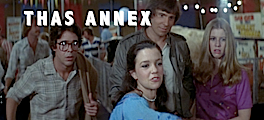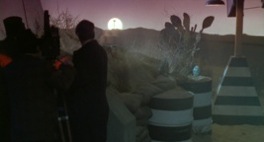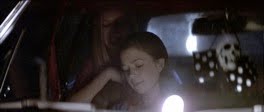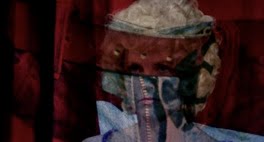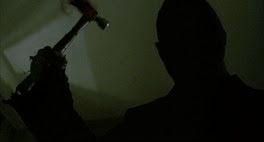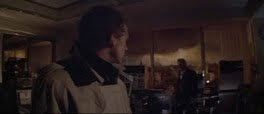In this one shot from Invaders from Mars, Hooper cements his interest in movement, staging, balletic composition and minute expressiveness, and a foremost emotive, pure-natured formalism that combines emotionality (in lesser form, it would be called "sentimentality") with uncommonly understated visual eloquence (an anti-bombast), a constructivist rigor, and clear, directed rhetoric, cerebral in the way that it manifests emotions rather than manipulates ours. Hooper achieves great refinement and meaning with his daintiest, most unassuming of soulful film-making.
... The shot begins with all three members of the family in natural action...
... Father then moves off frame to the right...
... Mother, once she has finally gotten David into bed, also moves off right, and the camera follows her and leaves David, since presumably David is now in a static state and Mother remains the only active figure...
... But in a sweetly visualized, dexterously executed bit of visual wit, as the camera follows the Mother, we see David suddenly sit up and, like an unlikely shark in a riding wave, lurk stealthily at the edge of the frame, dorsal head only barely peeking into the shot as it sweeps right. In this tickling manner, he undermines the very omniscience of the camera-frame (the presumptuous child that he is)! His actions are not dictated by the existence of the camera on him! With this, I arrive at why this little moment (of sweet childishness, of depicting a boy's unremitting wonderment at the presence of his parents) is wonderfully, effortlessly rhetorical of formal construct, just as much as it is sentiment or stylistic whimsy.
... The camera movement ends with a framing that arrives on the parents at the end of the room. As it comes to its stop, David emerges fully into the foreground of the shot, his insurmountable figure perceiving the perspective-scaled figures of his parents at the far right of the frame and at a marked remove...
... The Father, who disappeared early in the shot, makes his anticipated (but not totally expected at this particular moment) reappearance--- and it is almost magical, for it is a sort of reveal. We did not know he was fetching one of his son's astronomy magazines in order to go to his son's desk and sit and read it. All we know is that he exited the frame. So when he reappears, and his present action is revealed, a small wonder is this sight of him: happily contenting himself in a child's desk, blithely occupying himself with a juvenile star magazine (despite being a full-grown, professional NASA scientist). This is emotive staging: he exits early in the shot (again, for a reason not made artlessly explicit), and it is for this pay-off: being introduced back into the shot with some additional small revelations about his character and humanity. In display here is Hooper's exquisite orchestrations of continuity and existent bodies, and his visual and emotional adroitness. This is a great example of how Hooper's films are always in character-developing mode*, for he is always crafting with this sort of attention to character development (or general emotional development), made through an artful camera and visuals.
* (quote from the post "THAS: The Film Grammar I":) "Hooper's sequences move forward through phrases and completed sentences, the effort to communicate within that structural, grammatical order never dropped. Instead of stutters dictated by narrative and expository beats, Hooper, by composing above those things (and instead in the grammatical order), is then instinctively crafting always in devotion to rich character observation and emotional beats..."
The Scene, Again










There is such graphical poignancy in the final three stills, where David's posture is shifting. He enters into three equally striking, differently-feeling positions in his regarding of his parents. Although it is a continuous movement executed by Carson, they are pronounced enough beats in the actual shot that I feel it would not misrepresent the scene to present them in their isolated expressiveness, as perhaps three intended emotional beats, strongly present, even if the reality is it was not at all painstakingly premeditated.

Large in foreground; visual poignancy found in his separation and observance.

The existence of two spheres of space becomes explicit as David effectively cuts the vertical extent of the frame; the frame seen now as a flat 2-d graphical field, David now can be said to be facing them, left looking right, the right side of the frame practically a quadrilateral screen unto itself that David views -- but of course we know he still occupies a different lateral plane in the 3-d reality (and so is of course looking along a depth axis as well); visual poignancy found in this rich blurring of dimensional space; visual poignancy found in his separation, childish activity (his leaning in), and observance.

David dips down in the frame, and effectively goes at ease as his parents display their affection that they have for each other; the camera has by now pulled in closer to the parents, and so David is not so much "foregrounded" now (by virtue of size, as his parents now occupy almost as much 2-dimensional screen area as he does); visual poignancy found in David's observance, and in its diminishing of David and enhancing of the parents, as it enters the world of the Mother and Father, their love and adult relationship - David a little bit more out of the loop in matters of this.
An Observing Child

Large in foreground; visual poignancy found in his separation and observance.

The existence of two spheres of space becomes explicit as David effectively cuts the vertical extent of the frame; the frame seen now as a flat 2-d graphical field, David now can be said to be facing them, left looking right, the right side of the frame practically a quadrilateral screen unto itself that David views -- but of course we know he still occupies a different lateral plane in the 3-d reality (and so is of course looking along a depth axis as well); visual poignancy found in this rich blurring of dimensional space; visual poignancy found in his separation, childish activity (his leaning in), and observance.

David dips down in the frame, and effectively goes at ease as his parents display their affection that they have for each other; the camera has by now pulled in closer to the parents, and so David is not so much "foregrounded" now (by virtue of size, as his parents now occupy almost as much 2-dimensional screen area as he does); visual poignancy found in David's observance, and in its diminishing of David and enhancing of the parents, as it enters the world of the Mother and Father, their love and adult relationship - David a little bit more out of the loop in matters of this.



































